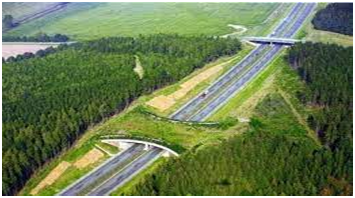Green Highway Policy 2015
About the policy :
- The Ministry of Road Transport and Highways (MoRTH) had launched a National Green Highways Mission (NGHM) following the promulgation of ‘Green Highways Policy’ in September 2015.
- The Green Highway Policy helps in making India pollution free.
- It also help in curtailing the number of road accidents in India. The vision of the policy is to provide dignified employment to local people and communities.
- the entire Highways network is to be divided into two categories based on the legal status of the existing road-side plantations.
- in areas, where existing plantations along the Highways have been notified as protected forests as plantation is either done by the forest department for management purpose or naturally grown trees.
- For these areas, permission for tree cutting is required to be taken from the forest department under the Forest Conservation Act, 1980.
- While granting the permission, the forest department stipulates the conditions not only for compensatory afforestation but also for avenue plantations.

- in other areas, the roadside plantations may be taken up either through the contractor (if it is aA BOQ item) or the Concessionaire (if it is included in the concession agreement), forest department and department dealing the Watershed Development in the State, Watershed Cellcum-Data Centre[WCDC] at district level and the Watershed Committee [WC] at local level with local communities/local self government/Women Self Help Groups (WSHGs)/Self Help Groups (SHGs)/Joint Forest Management Committees (JFMC), or through open bidding by empanelled agencies
Vision:
- To develop eco friendly National Highways with participation of the community, farmers, NGOs, private sector, institutions, government agencies and the Forest Department for economic growth and development in a sustainable manner
Objectives :
- To evolve a policy framework for plantation along National Highways
- To reduce the impact of air pollution and dust as trees and shrubs are known to be natural sink for air pollutants
- To provide much needed shade on glaring hot roads during summer
- To reduce the impact of ever increasing noise pollution caused due to increase in number of vehicles
- To arrest soil erosion at the embankment slopes
- To prevent glare from the headlight of incoming vehicles
- To moderate the effect of wind and incoming radiation
- To create employment opportunities for local people.
Important:
- Loss of vegetation is one of the inevitable consequences of Highway Development. It is the responsibility of the highway development agencies to offset this loss by way of following the approach of Corridor Development
- The highway development agencies must strive to enhance the aesthetics of the highway corridor at all possible locations. Highways shall not be looked upon merely as a means of transportation, but an integral part and parcel of the physical environment and economic milieu.
- Often, while preparing the Land acquisition Plans for the highway projects, the land needed for the avenue plantation and landscape improvement is not considered during the DPR stage.
- As a result, after construction, when the planting is actually to start, there is no option but to accommodate planting in whatever space available. The width of the remaining ROW is, many times, not to accommodate even a single row of plants; whereas at some places, three to four rows can be planted. In order to ensure availability of width throughout for avenue planting, it is necessary that the requirement of land for tree plantation shall be included in the Land Acquisition Plans prepared by the DPR consultants.
Empanelment of Plantation Agencies.
- Ministry of Road Transport and Highways will appoint an authorised agency for empanelment of Plantation Agencies.
- A separate panel of Agencies having specialisation in Transplanting of trees will also be prepared. Only empanelled agencies will be allowed to bid for planting work on the National Highways.
- Following types of agencies are eligible
- Government or Private Sector companies.A NGO’s registered as societies, trusts or private limited non-profit companyA Federations/ Producer OrganizationsA Informal Agencies viz. Self-Help Groups/ Water User Associations/ Joint ForestA
How much area is available in the country for plantation along highways? :
At present, the National Highways in the Country cover about one lakh Km. Most of this length is available in varying widths.
What are the general criteria for empanelling agencies? :
- Agencies should be registered under respective relevant acts like Companies ActA 1956, Societies Registration Act 1860, Public Trust Acts etc. (Not applicable for Informal agencies) Should have operational existence for not less than 3 years.
- Should have positive net worth for past three years.
- Experience in implementing plantation works and its related maintenance (EarlierA Road plantation experience will be preferred)/ Experience of work in related areas like Watershed/ Land Development/ Grasslands and pastures Development.
- Informal agencies must have past experience in social mobilization Should have adequate resources, manpower and infrastructure to implement the project Should be willing and capable of implementation of project till completion.
- Should not have record of poor performance such as abandoning the services allotted, not completed, inordinate delays in completion, litigation history or financial failure.
- Should not be disqualified/ blacklisted or under any investigation for being disqualified or blacklisted by any Financial Institution/Reserve Bank of India, Indian Banks Association and/ or by any other Bank/ Govt. Agency
Subscribe
0 Comments





